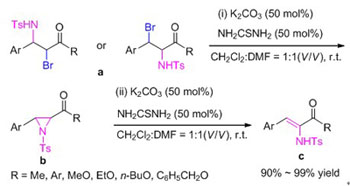[1] Ferreira, P. M. T.; Monteiro, L. S.; Coban, T; Suzen, S. J. EnzymeInhib. Med. Chem. 2009, 24, 967.
[2] Kong, Y.; Yang, W.; Wu, W.-T. Pharm. Biotechnol. 2007, 14, 230. (孔毅, 杨婉, 吴梧桐, 药物生物技术, 2007, 14, 230.)
[3] Lanigan, G. W.; Payne, A. L.; Smith, L. W.; Wood, P. M.; Petterson, D. S. Appl. Environ. Microbiol. 1979, 37, 289.
[4] Plate, R.; Akkerman, M. A. J.; Ottenheijm, H. C. J. J. Chem. Soc. Perkin Trans. 1 1987, 2481.
[5] Bonauer, C.; Walenzyk, T.; Konig, B. Synthesis 2006, 1.
[6] Armstrong, R. W.; Moran, E. J. J. Am. Chem. Soc. 1992, 114, 371.
[7] Schmidt, U.; Lieberknecht, A.; Wild, J. Synthesis 1988, 159.
[8] Alcaraz, L.; Macdonald, G.; Ragot, J.; Lewis, N. J.; Taylor, R. J. K. Tetrahedron 1999, 55, 3707.
[9] Chang, L. C.; Bhat, K. P. L.; Pisha, E.; Kennelly, E. J.; Fong, H. H. S.; Pezzuto, J. M.; Kinghorn, A. D. J. Nat. Prod. 1998, 61, 1257.
[10] Zhou, H.; Donk, W. A. V. D. Org. Lett. 2001, 3, 593.
[11] Zhou, H.; Donk, W. A. V. D. Org. Lett. 2002, 4, 1335.
[12] Pereira, G.; Abreu, A. S.; Castanheira, E. M. S.; Coutinho, P. J. G.; Ferreira, P. M. T.; Queiroz, M.-J. R. P. Eur. J. Org. Chem. 2009, 3906.
[13] Pereira, G.; Castanheira, E. M. S.; Ferreira, P. M. T.; Queiroz, M.-J. R. P. Eur. J. Org. Chem. 2010, 464.
[14] Sibi, M. P.; Asano, Y.; Sausker, J. B. Angew. Chem., Int. Ed. 2001, 40, 1293.
[15] Miossec, B.; DanionBougot, R.; Danion, D. Synthesis 1994, 1171.
[16] Burk, M. J.; Allen, J. G.; Kiesman, W. F.; Stoffan, K. M. Tetrahedron Lett. 1997, 38, 1309.
[17] Manzoni, L.; Colombo, M.; Scolastico, C. Tetrahedron Lett. 2004, 45, 2623.
[18] Horikawa, H.; Nishitani, T.; Iwasaki, T.; Mushika, Y.; Inoue, I.; Miyoshi, M. Tetrahedron Lett. 1980, 21, 4101.
[19] Bartels, A.; Peter, G. J.; Liebscher, J. Tetrahedron Lett. 1995, 36, 3673.
[20] Bartels, A.; Jones, P. G.; Liebscher, J. Synthesis 2003, 67.
[21] Tang, W.; Zhang, X. Chem. Rev. 2003, 103, 3029.
[22] Enthaler, S.; Erre, G. Eur. J. Org. Chem. 2008, 3352.
[23] Chen, W. P.; Mbafor, W. J. Am. Chem. Soc. 2006, 128, 3922.
[24] Ferreira, P. M. T.; Maia, H. L. S.; Monteiro, L. S. Tetrahedron Lett. 1999, 40, 4099.
[25] Abreu, A. S.; Silva, N. O.; Ferreira, P. M. T.; Queiroz, M. J. R. P. Eur. J. Org. Chem. 2003, 1537.
[26] Bull, S. D.; Davies, S. G.; O'Shea, M. D. J. Chem. Soc., Perkin Trans. 1 1998, 3657.
[27] Srinivasan, M.; Perumal, S.; Selvaraj, S. ARKIVOC 2006, 10, 21.
[28] Weigel, W.; Henning, H.-G. Chem. Commun. 1997, 19, 1893.
[29] Sant, K. V.; South, M. S. Tetrahedron Lett. 1987, 28, 6019.
[30] Padwa, A.; Eisenhardt, W. J. Org. Chem. 1970, 35, 2472.
[31] Chen, D.-J.; Guo, L.; Liu, J.-Y.; Kirtane, S.; Cannon, J. F.; Li, G.-G. Org. Lett. 2005, 7, 921.
[32] Pak, C. S.;Kim, T. H.; Ha, S. J. J. Org. Chem. 1998, 63, 10006.
[33] Chen, Z.-G.; Wei, J.-F.; Li, W.-L.; Wang, Y.; Zhao, P.-F.; Shi, X.-Y. Chin. J. Chem. 2011, 29, 1689.
[34] Chen, Z.-G.; Zhou, J.-M.; Wang, Y.; Li, W.-L. Acta Chim. Sinica 2011, 69, 2851. (陈战国, 周继梅, 王芸, 李文丽, 化学学报, 2011, 69, 2851.)
[35] Li, W.-L.; Chen, Z.-G.; Zhou, J.-M.; Hu, J.-L.; Xia, W. Chin. J. Chem. 2012, 30, 830.
[36] Chen, Z.-G.; Wang, Y.; Wei, J.-F.; Zhao, P.-F.; Shi, X.-Y. J. Org. Chem. 2010, 75, 2085.
[37] Chen, Z.-G.; Zhou, L.-Y.; Li, W.-L.; Zhou, J.-M.; Wang, C.-N. Acta Chim. Sinica 2011, 69, 1093. (陈战国, 周利燕, 李文丽, 周继梅, 王传宁, 化学学报, 2011, 69, 1093.)
[38] Wei, J.-F.; Chen, Z.-G.; Gao, Y.-N.; Zhang, P.; Wang, C.-N.; Zhao, P.-F.; Wang, Y.; Shi, X.-Y. Chin. J. Chem. 2012, 30, 391. |
